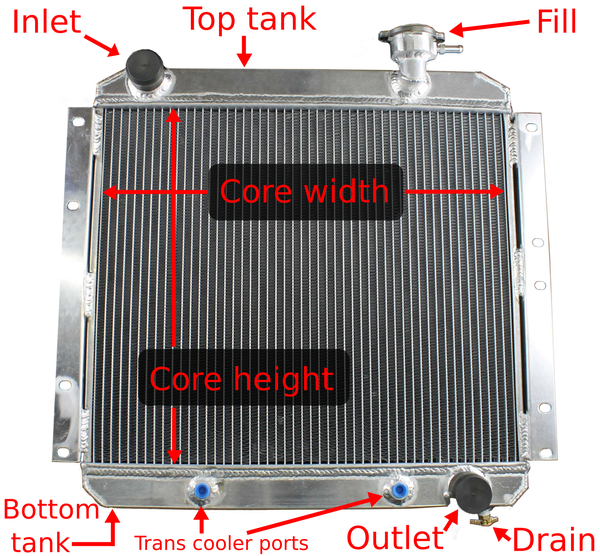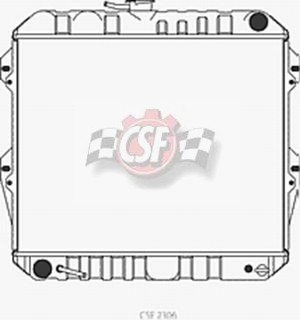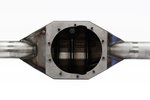The Best Radiator for Your 1995 and Earlier Toyota Pickup or 4Runner

If you have a 4 cylinder 22R or 22RE, it’s very likely that you have a 2 row radiator. For normal folks this is pretty sufficient. They might go to the grocery store, throw a couple 2x4s in the back at the home center, or shuttle the kids around.
But we’re Toyota off roaders!
We typically haul more weight, move slowly on trails (which means no highway speed airflow over the engine), and we need serious reliability. So what radiator bolts in to our Toyota and boosts our cooling capacity?
Why a 3 Row Radiator is Better for Your Toyota
One of the best ways to keep your Toyota's engine cool is by upgrading to a 3
row radiator. While there are other 3 row radiators, one of the most popular for bolting into early Toyotas is the CSF 2314. Why does going from a 2 row to a 3 row help?
The huge area in the middle of the radiator with the thin, easily damaged parts is the core. The core is made up of flat vertical tubes that carry hot coolant from the top tank to the bottom tank, which is cooled along the way by air moving over the tubes and fins. The thin fins are soldered to the radiator tubes and dissipate heat that is being carried by the coolant.

The tubes (horizontal in this image) carry coolant from one tank to the other. The approximately four quabillion fins that zigzag between the tubing provide extra surface area for heat to dissipate. A few smooshed fins aren't so bad, but a damaged tube will leak coolant. This radiator is a coolant leaker.
It's all about the airflow.
In a 2 row radiator, there are 2 rows of tubes. In a 3 row radiator there are 3 rows of tubes. A radiator with more rows is typically thicker than one with fewer rows and will hold more coolant. And (this is more important) the extra row of tubing and fins tremendously increases the surface area that is exposed to the air. For the same amount of airflow, excess heat has more surface area from which to dissipate.
Scenario #1: High Speed
Imagine you’re driving your rig to Moab on the highway, since you’re an adventurous
soul and you love the lulling whine of bias-ply Swampers on pavement.
In this situation, your 22RE won’t overheat. At highway speeds, your
engine is being swiftly cooled by air that passes quickly through the
radiator and over and around the engine.
Your coolant needs to circulate through your radiator, of course, but there is so much airflow from wind that you’d never worry about overheating. Theoretically, if you always ran at highway speeds you could probably run without a fan.
Scenario #2: Low Speed
Now imagine you’re in Moab, moving along in 4-low on a twisty canyon
trail. You are miles from civilization, hauling camping gear, and spare
parts. Besides
your pickup’s 37” Swampers there is about 600 lbs. of tube and winch
also weighing your truck down. It’s 95 degrees out. In this situation,
you are relying solely on the airflow from your fan plus the available
surface area of your radiator.
You depend on your fan pushing enough air, the air being guided to your radiator by a sufficient shroud, and your radiator being able to flow a high volume of coolant with sufficient heat dissipation surface. With less available airflow radiator surface area is very important.
Now we’re not saying you’re going to die in the desert because you didn’t have a three row radiator (probably alone, surrounded by beer cans and tears). But we are saying that a fresh 3-row radiator will give you peace of mind in a Toyota that needs to perform in the heat at trail speeds.
This radiator is one of the most popular for swapping into pre-'95 Toyota pickups and 4Runners.
Other great things about three row Toyota radiator swaps
You can swap in a Toyota V6 engine and you’ll already have the cooling capacity.
Planning a 6 cylinder 5VZFE swap? You’ll need a bigger radiator and the three row will do the job.
Built in auto transmission cooler.
Most of these radiators have a transmission cooler in the bottom. If
you run an auto trans, this is great. You can get your trans fluid up
to temp a little faster and keep it where is needs to be. If you run a
manual trans, you wouldn’t use this cooler. However, in some
circumstances, you might decide to plumb in your steering so that you
can keep your steering running cool. If you don’t have a use for it,
plug the holes with something you can remove later.
These radiators are all metal.
Most radiators today are made by gluing plastic tanks to aluminum cores.
In fact, it’s quite possible that if you just order a Toyota pickup or
4Runner replacement radiator willy-nilly you’ll end up with a
plastic/aluminum radiator - you won’t even get a factory-like radiator.
While this newer type seems okay we like the fact that metal
radiators have brazed seams and can be repaired by a competent radiator
shop. Plastic/aluminum radiators are generally throwaway parts when you
have a problem.
Will a Three Row Radiator Fit Your Toyota?
A three row Toyota radiator is a bolt-in replacement for many Toys! The bolt holes match up and the inlet and outlet are properly sized and placed. Although thicker, this doesn’t interfere with the fan.
3 Core Radiators for Pre-'95 Toyota Pickups and 4Runners
As far as we can tell, a 2314 will bolt in without modification to 1984-1995 4Runners and 1986-1995 Toyota pickups. That said, this should also be a near bolt-in Toyota Hilux radiator for earlier, pre-1984 trucks. The biggest issue you may have is that some hardware may be different. Early trucks use 12mmx1.25M hardware to hold the fan shroud. The CSF 2314 will come with 10mmx1.0M nuts welded to the engine side of the radiator. In other words, be sure to have some 10mmx1.0M bolts around just in case. 30mm long ought to do it.
3 Core Radiators for Toyota Tacomas
People have adapted the 2314 radiator to Tacomas. Tacomas have a single core
plastic/aluminum radiator. The inlets and outlets are on the same sides
as the radiators in our table below and are the same sizes. However,
they are much taller and wider (and thinner!): 22 5/8” x 25 1/4” x
15/16”. A 2314 or one of the other three cores requires custom brackets
to fit into a Tacoma, so this is not a bolt-on mod for Tacos.
How to Determine the Size of Your Radiator
You should know a few things about your radiator so that you can ID what you have and pick the correct new radiator. Check out our diagram:

Note that the core includes only the tubes and fins - not the bracketry, top and bottom tanks, or anything else.
One important thing we’d like to point out is that the core is only the tubes and fins.
The core does not include the tanks. The core does not include
mounting brackets, shrouds, extra bolt holes, inlet/outlet, or anything
else. Fins and tubes only. On a side note, it is possible to get your radiator repaired if you have an all-metal one. Here is an overview of radiator repair that a shop might do. Radiators with aluminum cores and plastic tanks almost always have to be replaced.
Toyota Two and Three Row Radiator Specs
We suggest that you measure your core to make sure you’re picking the correct size radiator. If you're fitting a radiator and you don't know exactly what you need look closely at our images below and particularly note:
- core size
- fill location
- oil tank width and port placement
- fill placement
- drain placement
Some of their locations are different and could prevent a radiator from fitting in your Toyota.
You’ll notice that on most of these radiators, the biggest difference is the height of the core. All of these radiators have the same core width (Don’t confuse this with thickness!), inlet location/size, and outlet location/size. If you’re upgrading a 1984/1985 4Runner or a 1986-1995 Toyota mini from a stock two core radiator to a three core, you most likely want the CSF 2314. The ONLY significant dimensional difference between the stock radiator (in the table this is the two row CSF 850 or the CSF 895) and the 2314 is the number of rows and a slight height difference. Your stock radiator cap will even fit.
What are these funny nipples sticking out at the bottom?
You may notice that your new radiator has two hose barbs on the bottom of the radiator. These are normally used as automatic transmission coolers. If you want you can cap it off to keep dirt out of it if you won't be using it. It is completely separate from the main part of the radiator so it won't leak coolant if you don't cap off the two ports. Some wheelers use the tranny cooler to cool power steering fluid by running the low pressure line from the steering box to the cooler.
Toyota 3-Row Radiator CSF 2314
| Part number | 2314 |
|---|---|
| Rows | 3 |
| Core size (height x width x thickness) | 15 3/4" x 20 11/16" x 2 1/16" |
| Inlet tank size | 20 1/8" x 2 3/16" |
| Outlet tank size | 20 1/8" x 2 3/16" |
| Top hose fitting | 1 3/8" passenger side |
| Bottom hose fitting | 1 3/8" driver side |
| Oil cooler size | 14 3/4" |
| OEM Part # | 16400-35360 (HD) |
| Construction | All Metal |
This radiator is one of the most popular for swapping into pre-'95 Toyota pickups and 4Runners.
Toyota 3-Row Radiator CSF 2306
| Part number | 2306 |
|---|---|
| Rows | 3 |
| Core size (height x width x thickness) | 16 3/4" x 20 11/16" x 2 1/16" |
| Inlet tank size | 20 1/8" x 2 3/16" |
| Outlet tank size | 20 1/8" x 2 3/16" |
| Top hose fitting | 1 3/8" passenger side |
| Bottom hose fitting | 1 3/8" driver side |
| Oil cooler size | 14 3/4" |
| OEM Part # | 16400 - 35380 |
| Construction | All Metal |
Toyota 3-Row Radiator CSF 2055
| Part number | 2055 |
|---|---|
| Rows | 3 |
| Core size (height x width x thickness) | 17 3/4" x 20 11/16" x 2 1/16" |
| Inlet tank size | 20 1/8" x 2 3/16" |
| Outlet tank size | 20 1/8" x 2 3/16" |
| Top hose fitting | 1 3/8" passenger side |
| Bottom hose fitting | 1 3/8" driver side |
| Oil cooler size | 10 3/16" |
| OEM Part # | 16400 - 35520; 16400 - 35530 |
| Construction | All Metal |
Toyota 3-Row Radiator CSF 2056
| Part number | 2056 |
|---|---|
| Rows | 3 |
| Core size (height x width x thickness) | 18 11/16" x 20 11/16" x 2 1/16" |
| Inlet tank size | 20 1/8" x 2 3/16" |
| Outlet tank size | 20 1/8" x 2 3/16" |
| Top hose fitting | 1 3/8" passenger side |
| Bottom hose fitting | 1 3/8" driver side |
| Oil cooler size | 14 3/4" |
| OEM Part # | 16400 - 65040; 16400 - 65060; 16400 - 65100; 16400 - 65120 |
| Construction | All Metal |
Toyota 3-Row Radiator CSF 2057
| Part number | 2057 |
|---|---|
| Rows | 3 |
| Core size (height x width x thickness) | 17 3/4" x 20 11/16" x 2 1/16" |
| Inlet tank size | 20 1/8" x 2 3/16" |
| Outlet tank size | 20 1/8" x 2 3/16" |
| Top hose fitting | 1 3/8" passenger side |
| Bottom hose fitting | 1 3/8" driver side |
| Oil cooler size | 14 3/4" |
| OEM Part # | 16400 - 65030; 16400 - 65050; 16400 - 65090; 16400 - 65110 |
| Construction | All Metal |
Toyota 3-Row Radiator CSF 850
| Part number | 850 |
|---|---|
| Rows | 2 |
| Core size (height x width x thickness) | 15 3/4" x 20 11/16" x 1 5/16" |
| Inlet tank size | 20 1/8" x 1 9/16" |
| Outlet tank size | 20 1/8" x 1 9/16" |
| Top hose fitting | 1 3/8" passenger side |
| Bottom hose fitting | 1 3/8" driver side |
| Oil cooler size | 10 13/16" |
| OEM Part # | 16400 - 35100; 16400 - 35110; 16400 - 35130; 16400 - 35140; 16400 - 35200; 16400 - 35210; 16400 - 35340; 16410 - 35110 |
| Construction | All Metal |
Toyota 3-Row Radiator CSF 895
| Part number | 895 |
|---|---|
| Rows | 2 |
| Core size (height x width x thickness) | 15 3/4" x 20 11/16" x 1 5/16" |
| Inlet tank size | 20 1/8" x 1 9/16" |
| Outlet tank size | 20 1/8" x 1 9/16" |
| Top hose fitting | 1 3/8" passenger side |
| Bottom hose fitting | 1 3/8" driver side |
| Oil cooler size | 14 3/4" |
| OEM Part # | 16400-35350; 16400-35360 |
| Construction | All Metal |
Last updated: June 3, 2019














